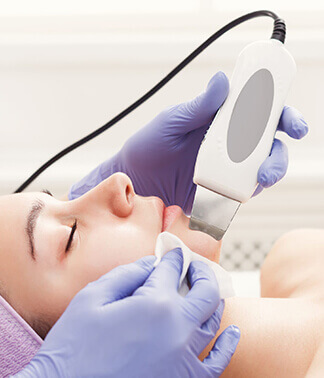Blepharoptosis

Blepharoptosis is a common condition where one or both upper eyelids droop. It is one of the most frequently encountered conditions seen in an Oculoplastic Surgery practice. In mild cases, this can cause cosmetic concerns. It causes a tired appearance which will reduce an individual’s self-esteem. In more severe cases, it can cause a reduction in visual acuity and in peripheral vision. This can lead to difficulty reading, driving, and performing other daily activities.
Ptosis can be present in one or both eyelids. Although the most common cause of blepharoptosis is an age-related stretching or dehiscence of the levator muscle, there are many other causes. Therefore, it is recommended that every patient with new onset ptosis undergo an evaluation to determine the cause and discuss possible treatment options.
In order to assess ptosis a very basic understanding of the anatomy is required. The majority of eyelid lifting is performed by the levator palpebral muscle. This muscle orginates at the posterior aspect of the orbit and inserts into the eyelid. It is under the control of the superior branch of the Third Cranial Nerve. The second muscle that elevates the eyelid is Muellers Muscle. This small muscle is in the eyelid posterior to the Levator Muscle. It is under autonomic control by the sympathetic nervous system and is responsible for small movements of the eyelid.
Since ptosis has many causes it is important to take an excellent history. If a patient complains of variable ptosis and double vision, it is possible that this represents Myasthenia Gravis. If there is a history of trauma or long-term contact lens use it is more likely that the patient has a dehiscence of the levator muscle.
Physical examination for ptosis begins with a series of measurements of the eyelid. First, we look at the total aperture of the eyelid which is the distance between the upper and lower eyelid. This should normally be about 10mm. Next, we evaluate the Margin Reflex Distance (MRD). This is the distance between the eyelid margin and the light reflex of the cornea. The MRD1 is the distance between the upper eyelid margin and the corneal light reflex, while MRD2 measures the distance between the lower eyelid margin and the corneal light reflex. The MRD1 is the best indicator of how much the eyelid height is interfering with visual acuity. An MRD1 of 2mm or less is considered enough to cause visual field impairment.
The next measurement is how much the levator muscle moves. To measure the functionality of the levator muscle the patient is first asked to close their eyes and then open their eyelids and look up without elevating the eyebrow. The normal levator function is 10-15 mm. Typically, patients with age-related or levator dehisence causes of ptosis will maintain normal levator muscle movement while neurologic or congenital ptosis may have little or no levator movement.
Ptosis can be present at birth, developed during childhood, or acquired as an adult over time from an accident or a medical disorder. It will be necessary to differentiate whether Ptosis is congenital or acquired. This can be determined through the observation of the position of the Ptotic eyelid in a downward gaze. With congenital Ptosis the lid will appear higher in a downward gaze. In an acquired Ptotic eye the eyelid will remain Ptotic in all positions and could potentially worsen in downgaze. Furthermore, the patient’s history will most likely determine if the Ptosis is congenital or acquired.
There are many causes of blepharoptosis. Congenital Ptosis is seen at birth. It is usually due to a developmental defect of the levator muscle. development. The muscle fibers in a Congenital Ptotis are usually fibrotic and have poor movement. If the ptosis blocks the visual axis early intervention is required to prevent amblyopia.
Most forms of ptosis are acquired later in life. The most common type of ptosis is due to stretching or trauma of the levator aponeurosis. This can result from age, trauma, frequent eyelid rubbing, or long-term contact lens use. Usually a result of frequent eye rubbing, an injury to the eyelid, or even prolonged rigid contact lens usage.
Neurologic causes of ptosis are less common but are more concerning as they may be indicative of systemic neurologic disease. The three leading causes of Neurogenic ptosis are Myasthenia Gravis, third nerve palsy, and Horner’s Syndrome. Myasthenia Gravis is an autoimmune disorder caused by antibodies that block the post-synaptic acetylcholine receptors of the neuromuscular junction.
The third nerve supply is in control of four out of the six extraocular muscles and the levator muscle which lifts the eyelid. Third nerve palsy results in abnormal extraocular movements in addition to decreased elevation of the eyelid. As a result, it can cause ptosis and deviation of the eye outward and downward. Third Nerve palsy can either be congenital or acquired from different types of head trauma, infection, diabetes, high blood pressure, or inflammation. In cases where the pupil is dilated, it could be a sign of a compressive lesion or aneurysm. Urgent neuroimaging is required in these cases.
Horner syndrome is caused by the disruption of the sympathetic nerve pathway from the brain to the head and neck. It has a classic triad of ptosis, miosis (constricted pupil), and anhydrosis (lack of sweating on the ipsilateral side of the face). Horner’s Syndrome can occur due to a stroke, a tumor (classically a Pancoast tumor of the upper lobe of the ipsilateral lung), or spinal cord injury. While the vast majority of Horner’s Syndrome has no obvious cause, a neurologic workup should be done. Although rare, Horner’s Syndrome in children may be a sign of Neruoblastoma and require immediate attention.
Myogenic ptosis occurs when the levator muscles are weakened due to a systemic disorder causing muscle weakness. The conditions can include types of muscular dystrophy which results in progressive weakness and a decrease in muscle mass. If a patient has Chronic Progressive External Ophthalmoplegia (CPEO) this is usually hereditary, due to a genetic mutation. It is characterized as the loss of muscfunctions in the eye as well as eyelid movement. The deformity is present in the mitochondrial or nuclear DNA and, depending on the gene, has different inheritance patterns. In rare cases, orbital tumors can result in ptosis as well. The abnormal growths can impair vision. The abnormal growths may be either benign or metastatic.
Surgery
Depending on your severity or type of Ptosis there are three major types of surgery available. The majority of ptosis cases are due to levator muscle dehiscence or weakening. As long as there is good movement of the levator muscle (in general more than 4 mm of levator movement) then surgery is performed by tightening or tucking the levator muscle. This operation is generally performed with either light sedation or under local anesthesia. A cutaneous incision is created along the crease of the upper eyelid. Dissection is carried out through the orbicularis muscle and orbital septum. The anterior orbit is entered and the levator muscle is found approximately 10mm above the lid margin. The levator muscle is then advanced and sutured into the tarsus. The patient is then woken up and asked to open their eyelid to make any necessary adjustments in the height of the eyelid. Once the appropriate is assured then the skin incision is closed with sutures.
With a mild case of Ptosis, a Muellerectomy operation can be performed. The removal of the muller’s muscle will then result in a 1-3 mm eyelid elevation. This can be done under conscious sedation or local anesthesia. The eyelid is inverted and a specialized clamp (Putterman Clamp) is used to resect conjunctiva and Muellers muscle to elevate the eyelid. This procedure utilizes an algorithm to determine the amount of resection depending on the desired elevation. In general, no patient cooperation is required. The advantage of this operation is that it has a lower incidence of over or under-correction, however, the amount of elevation is limited to 2-3 mm. This is most commonly used in cosmetic ptosis cases.
In severe cases of ptosis when the levator muscle does not move properly (congenital ptosis and neurologic causes of ptosis) and the muscle is bypassed. A sling is surgically implanted and attaches to the eyelid to the fontalis muscle of the brow. After the sling is implanted the frontalis muscle is utilized to lift the lid. The sling is commonly made of either Silicone or Teflon, however fascia lata can also be used. Since this operation is most commonly used in Congenital ptosis it is performed under general anesthesia and the sling is tightened to place the eyelid at the superior margin of the cornea. This operation can also be performed on neurogenic ptosis where there is poor movement of the levator muscle.
Severe surgical complications are rare. The most common complication is either over-correction (eyelid is too high) or under-correction (eyelid is too low). When this occurs a corrective operation is usually performed within days or weeks of the original operation. Other potential complications include bleeding, infection, lagophthalmos (inability to fully close the eye), or exacerbation of dry eye.
Proper post-operative care is necessary for a good result and to avoid complications. The patients are instructed to rest and ice for several days after surgery. Patients are generally prescribed a topical antibiotic and are told to avoid bending and physical activities for 2 weeks after surgery. Contact lens users should be avoided in most cases for several weeks after surgery. Patients are usually seen one week after surgery for suture removal. Pain is very uncommon and can usually be treated with Acetomenophin. If possible, anticoagulants and NSAIDS should be avoided for 1 week prior to and 1 week after surgery.




